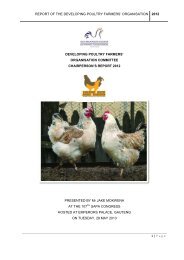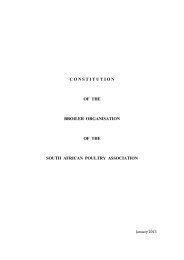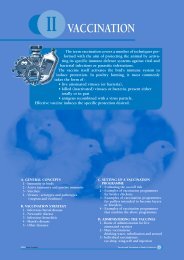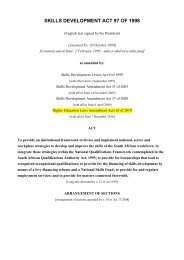Introduction to the Quality Council for Trades and Occupations (QCTO)
Introduction to the Quality Council for Trades and Occupations (QCTO)
Introduction to the Quality Council for Trades and Occupations (QCTO)
- No tags were found...
You also want an ePaper? Increase the reach of your titles
YUMPU automatically turns print PDFs into web optimized ePapers that Google loves.
<strong>Quality</strong> <strong>Council</strong> <strong>for</strong> <strong>Trades</strong> <strong>and</strong> <strong>Occupations</strong><strong>Introduction</strong> <strong>to</strong> <strong>the</strong><strong>Quality</strong> <strong>Council</strong> <strong>for</strong><strong>Trades</strong> <strong>and</strong><strong>Occupations</strong>(<strong>QCTO</strong>)
Contents1. His<strong>to</strong>rical context 3NQF review 3Joint policy statement 3New legislation <strong>and</strong> <strong>the</strong> establishment of <strong>the</strong> <strong>QCTO</strong> 42. What is <strong>the</strong> <strong>QCTO</strong>? 43. From difficulties <strong>to</strong> opportunities 5A quality council that provides a framework <strong>for</strong> various role-players 5An improved qualification model that suits occupational learning 5A qualifications design process that is responsive <strong>to</strong> labour-marketskills needs 5Curricula <strong>for</strong> guiding <strong>the</strong> creation of occupational learning programmes 6Reconceptualised unit st<strong>and</strong>ards that reflect <strong>the</strong> three <strong>for</strong>ms of learning 6Qualification assessment specifications <strong>for</strong> st<strong>and</strong>ardising assessments 6Revised rules of combination that reflect <strong>the</strong> differing requirementsof different occupations 7Multiple ETQAs combined in order <strong>to</strong> streamline quality-assuranceprocesses 7A ‘light-<strong>to</strong>uch’ accreditation process that promotes self-improvement 7A balance between flexibility <strong>and</strong> st<strong>and</strong>ardisation in order <strong>to</strong> achievecredible qualifications 84. Conclusion 82
1. His<strong>to</strong>rical contextNQF reviewThe aim of <strong>the</strong> review (which was initiated in 2001) was <strong>to</strong> investigate how <strong>the</strong>implementation of <strong>the</strong> NQF could be improved. Some notable successes <strong>and</strong> anumber of challenges were noted. One concern was that <strong>the</strong>re were <strong>to</strong>o manybodies responsible <strong>for</strong> st<strong>and</strong>ards generation <strong>and</strong> quality assurance, which led <strong>to</strong>confusion <strong>and</strong> <strong>the</strong> duplication of work. Also, <strong>the</strong>re was a need <strong>for</strong> <strong>the</strong> differentapproaches <strong>and</strong> practices within <strong>the</strong> education, training <strong>and</strong> skills developmentsystem <strong>to</strong> be accommodated. The design of <strong>the</strong> NQF architecture followed a‘one-size-fits-all’ approach <strong>and</strong> it became clear <strong>to</strong> all stakeholders that differentkinds of learning in different contexts required different qualification types <strong>and</strong>quality-assurance models. The review revealed that, although <strong>the</strong>re wasagreement on <strong>the</strong> NQF principles, not all of <strong>the</strong>se were reflected in practice.Joint policy statementFollowing <strong>the</strong> publication of <strong>the</strong> review findings, <strong>the</strong> Ministers of Education <strong>and</strong>Labour issued a joint policy statement in Oc<strong>to</strong>ber 2007. This document outlinedachievements <strong>to</strong> date <strong>and</strong> stressed <strong>the</strong> fact that South Africa’s NQF is integrated<strong>and</strong> includes all sec<strong>to</strong>rs <strong>and</strong> levels of education. The NQF objectives havereceived widespread support, <strong>and</strong> an awareness of <strong>the</strong> importance ofoutcomes-based education has been promoted.The Ministers also responded <strong>to</strong> <strong>the</strong> challenges that had emerged by agreeing<strong>to</strong> make provision <strong>for</strong> <strong>the</strong> establishment of three <strong>Quality</strong> <strong>Council</strong>s (QCs) <strong>to</strong>manage three subframeworks, one <strong>for</strong> Higher Education Qualifications, one <strong>for</strong>General <strong>and</strong> Fur<strong>the</strong>r Education Qualifications <strong>and</strong> one <strong>for</strong> OccupationalQualifications. These subframeworks fall within a single National QualificationsFramework (NQF) <strong>and</strong> are managed in collaboration with <strong>the</strong> South AfricanQualifications Authority (SAQA).This provides an opportunity <strong>to</strong> explore new ways of working <strong>to</strong>ge<strong>the</strong>r <strong>and</strong>developing strong communities of trust.3
New legislation <strong>and</strong> <strong>the</strong> establishment of <strong>the</strong> <strong>QCTO</strong>The Skills Development Act Amendment Bill introduces <strong>the</strong> <strong>Quality</strong> <strong>Council</strong> <strong>for</strong><strong>Trades</strong> <strong>and</strong> <strong>Occupations</strong> (<strong>QCTO</strong>), which will coordinate learning <strong>to</strong>wardsoccupational competence within our national learning system. The council will belegally established by April 2009, with <strong>the</strong> aim of becoming fully functional byApril 2010.The Skills Development Act Amendment Bill will facilitate <strong>the</strong> development of adem<strong>and</strong>-driven occupational learning system that will provide relevan<strong>to</strong>ccupational skills (especially in terms of workplace experience) <strong>and</strong> be lessbureaucratic. The <strong>QCTO</strong> will ensure that learning programmes can bedeveloped <strong>to</strong> address specific scarce <strong>and</strong> critical skills needs. The legislationalso allows <strong>for</strong> different kinds of learnerships, so that apprenticeships <strong>and</strong>internships can be accommodated <strong>and</strong> different learning routes can be selected.The <strong>QCTO</strong> recognises <strong>the</strong> need <strong>for</strong> all occupational learning <strong>to</strong> build on generalknowledge <strong>and</strong> <strong>the</strong>ory, <strong>and</strong> provides <strong>for</strong> linkages <strong>and</strong> partnerships with bothpublic <strong>and</strong> private provider systems. In order <strong>to</strong> fulfil its m<strong>and</strong>ate, <strong>the</strong> <strong>QCTO</strong> willcooperate closely with SAQA, <strong>the</strong> o<strong>the</strong>r QCs <strong>and</strong> professional bodies.2. What is <strong>the</strong> <strong>QCTO</strong>?The <strong>QCTO</strong> will manage <strong>and</strong> coordinate <strong>the</strong> qualifications in <strong>the</strong> occupationalqualifications framework in terms of <strong>the</strong>ir development, provision, assessment<strong>and</strong> impact. Its scope will be <strong>the</strong> development <strong>and</strong> quality assurance offit-<strong>for</strong>-purpose occupational qualifications <strong>and</strong> unit st<strong>and</strong>ards as required by <strong>the</strong>labour market <strong>for</strong> work <strong>and</strong> employment purposes.The <strong>QCTO</strong> will develop fit-<strong>for</strong>-purpose occupational qualifications that will becertificated as National Occupational Awards or National Skills Certificates. Theawards will name <strong>the</strong> relevant occupation that <strong>the</strong> learner is now competent <strong>to</strong>practice. The focus of occupational qualifications will be <strong>the</strong> development ofoccupational competence which, in turn, contributes <strong>to</strong> increased employmentrates <strong>and</strong> productivity.The envisaged structure <strong>and</strong> functions of <strong>the</strong> <strong>QCTO</strong> reflect a new approach <strong>to</strong>quality assurance, in which quality assurance permeates all activities <strong>and</strong> is notseen as a separate function. This model was developed in response <strong>to</strong> appeals<strong>to</strong> bring qualifications development <strong>and</strong> quality assurance ‘under one roof’.The quality assurance of <strong>the</strong> learning process <strong>for</strong> <strong>the</strong> <strong>QCTO</strong>’s qualifications can4
e visualised as a structure in which <strong>the</strong> roof is supported by two pillars: design<strong>and</strong> development on <strong>the</strong> one side, <strong>and</strong> <strong>the</strong> assessment of occupationalcompetence on <strong>the</strong> o<strong>the</strong>r. The system is quality managed from <strong>the</strong> overarching‘roof’, representing moni<strong>to</strong>ring <strong>and</strong> evaluation through data analysis <strong>and</strong>research. This entire structure illustrates <strong>the</strong> quality-assurance model.3. From difficulties <strong>to</strong> opportunitiesIn addressing a number of NQF implementation problems, <strong>the</strong> <strong>QCTO</strong> providesan opportunity <strong>to</strong> find viable <strong>and</strong> powerful solutions, some of which are outlinedbelow:A quality council that provides a framework <strong>for</strong> variousrole-playersThe many role-players <strong>and</strong> structures active in <strong>the</strong> labour market, such asSETAs, SGBs, providers, assessors <strong>and</strong> professional bodies, have created asituation that is overcomplex <strong>and</strong> inefficient. The <strong>QCTO</strong> provides a coordinatingframework <strong>to</strong> support <strong>the</strong>se role-players so that <strong>the</strong>y can focus on what <strong>the</strong>y dobest <strong>and</strong> give coherence <strong>to</strong> <strong>the</strong>se activities as a whole.An improved qualification model that suits occupationallearningWorkers need <strong>to</strong> be competent in three areas of learning in order <strong>to</strong> be able <strong>to</strong>practise a particular occupation effectively, namely with regard <strong>to</strong> <strong>the</strong> –● knowledge <strong>and</strong> <strong>the</strong>ory component● practical skills component● work experience component.The new model values each of <strong>the</strong>se components equally. It differs from <strong>the</strong>previous qualification model in that it includes a structured work experiencecomponent.A qualifications design process that is responsive <strong>to</strong> labourmarket skills needsAs a starting point, <strong>the</strong> new model analyses <strong>the</strong> relevant occupations as listed in5
The <strong>QCTO</strong> will appoint, or recognise, suitable organisations as quality partnersin <strong>the</strong> design <strong>and</strong> management of <strong>the</strong>se external assessments.Revised rules of combination that reflect <strong>the</strong> differingrequirements of different occupationsLearners will have <strong>to</strong> demonstrate sufficient foundational competence incommunication <strong>and</strong> ma<strong>the</strong>matical literacy <strong>to</strong> cope with <strong>the</strong> occupational learningdem<strong>and</strong>s <strong>and</strong> <strong>to</strong> benefit from <strong>the</strong> learning process. Additional language,ma<strong>the</strong>matics or knowledge <strong>and</strong> <strong>the</strong>ory requirements in o<strong>the</strong>r subject areas willbe determined by <strong>the</strong> needs of each specific occupation <strong>and</strong> will befit-<strong>for</strong>-purpose. These will be incorporated in<strong>to</strong> <strong>the</strong> common/core learningrequirements of <strong>the</strong> qualification.The blanket, ‘fundamental’ requirements that existed be<strong>for</strong>e weretime-consuming <strong>and</strong> often resulted in <strong>the</strong> accumulation of credits that were notrelevant <strong>to</strong> <strong>the</strong> particular occupation. The new model thus removes a previousbarrier <strong>and</strong> relates <strong>the</strong> educational requirements <strong>to</strong> <strong>the</strong> particular job.‘Electives’ will be replaced by specialisations.Multiple ETQAs combined in order <strong>to</strong> streamlinequality-assurance processesThe establishment of <strong>the</strong> <strong>QCTO</strong> will significantly increase <strong>the</strong> efficiency of <strong>the</strong>current ETQA system, merging twenty-three SETA ETQAs in<strong>to</strong> one. This meansthat quality-assurance activities can be better coordinated <strong>and</strong> managed. Alloccupational unit st<strong>and</strong>ards will be quality assured by <strong>the</strong> <strong>QCTO</strong>.A ‘light-<strong>to</strong>uch’ accreditation process that promotesself-improvementPreviously, <strong>the</strong>re was an overemphasis on accreditation as <strong>the</strong> key <strong>to</strong> qualityassurance. The <strong>QCTO</strong> will simplify <strong>the</strong> accreditation process, applying criteriawhich are stated in each curriculum <strong>and</strong> are fit-<strong>for</strong>-purpose <strong>for</strong> each qualification.The process will begin with self-evaluation <strong>and</strong> will promote qualityimprovement. Overlapping accreditation, registration <strong>and</strong> verificationrequirements – currently causing major delays <strong>and</strong> frustrations, <strong>and</strong> escalatingcosts (especially <strong>for</strong> small providers) – will no longer apply.7
A balance between flexibility <strong>and</strong> st<strong>and</strong>ardisation in order <strong>to</strong>achieve credible qualificationsThe new model is flexible enough <strong>to</strong> maximise ‘fitness <strong>for</strong> purpose’, but includessufficient st<strong>and</strong>ardisation <strong>to</strong> ensure <strong>the</strong> credibility of <strong>the</strong> system.4. ConclusionThe new model aims <strong>to</strong> accelerate <strong>the</strong> processes <strong>for</strong> building occupationalcompetence <strong>and</strong> <strong>to</strong> improve <strong>the</strong> quality <strong>and</strong> credibility of learner achievements. Itdefines clear learning pathways <strong>to</strong>wards practice in an occupation in <strong>the</strong> actualworkplace setting.Its purpose is <strong>to</strong> improve <strong>the</strong> systems, processes <strong>and</strong> structures so that <strong>the</strong>y willbe more effective <strong>and</strong> efficient in addressing <strong>the</strong> skills crisis that is negativelyaffecting <strong>the</strong> achievement of South Africa’s employment, productivity, economicgrowth <strong>and</strong> social goals.It has been designed <strong>to</strong> ensure that <strong>the</strong> system is more responsive <strong>to</strong> labourmarket skills needs. The labour market includes industry <strong>and</strong> all types ofbusinesses, as well as <strong>the</strong> in<strong>for</strong>mal sec<strong>to</strong>r <strong>and</strong> <strong>the</strong> public sec<strong>to</strong>r.Finally, its main contribution will be <strong>to</strong> streng<strong>the</strong>n <strong>the</strong> ‘occupational arm’ of <strong>the</strong>NQF in order <strong>to</strong> accommodate <strong>the</strong> unique learning requirements <strong>for</strong> buildingoccupational competence. By streng<strong>the</strong>ning this ‘arm’ of <strong>the</strong> NQF, <strong>the</strong> <strong>QCTO</strong> willprovide an alternative pathway <strong>for</strong> young people <strong>and</strong> workers <strong>to</strong> access learning,work experience <strong>and</strong> employment.8
















